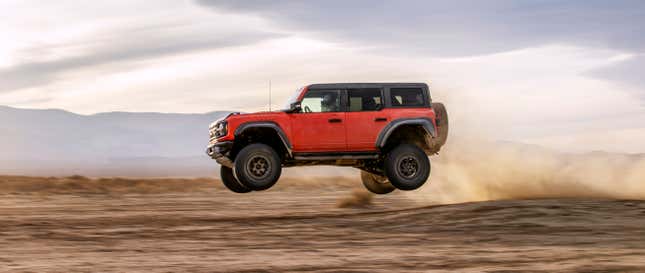Everybody loves the Ford Bronco. Pile your friends in, throw the top down, and head out to parts unknown — what’s not to like? But in a base Bronco, you may bemoan how long it takes you to reach those far-away dunes — or how little air you can get off the tops of them at full tilt. If those sound like complaints you’d have, never fear: Ford’s got a Bronco Raptor to make your SUV-jumping dreams come true.
We’ve known for a while that Ford was planning to bring the Raptor package to the Bronco, but camouflaged teaser photos left a lot to the imagination — specs, upgrades, even the truck’s final design. Now, not only do we have photos of the full truck, but we’ve got details concerning every upgrade over the base Bronco. Over all? The Raptor is taller, faster, and more capable.
The Raptor package, as in the Ranger and F-150, includes a grocery list of upgrades over the base Bronco. That starts with bespoke bodywork — the Raptor’s quarter panels, fenders, and flares are unique. The Raptor line’s signature “this vehicle is too wide for human roads” grille lights return in the revised front end, and they aren’t lying: The Raptor is a full 9.8 inches wider than the base truck. That added width covers new 37" tires, wrapped around optional beadlock wheels.
The tires and wheels, however, are far less interesting than what connects them to the truck’s frame. Fox shocks are the Raptor line’s bread and butter, and they show up on the Bronco with semi-active damping and and remote reservoirs in the rear. That all adds up to 13 inches of suspension travel up front and 14 inches out back, as well as a minimum ground clearance of 13.1 inches — 4.8 more than the base Bronco.

If upgraded suspension is the first step toward Raptordom, the second is always power. The Bronco Raptor will have a 3.0-liter twin-turbo EcoBoost V6, and Ford is “targeting” a horsepower number starting with a four — a nice upgrade over the 315 HP in the Bronco Wildtrak. Torque numbers haven’t been revealed, and likely won’t be until the engine’s power output is finalized.
That power makes its way to the ground through axles ripped from the race-spec Bronco DR, which also contributed to the Raptor’s additional 8.6 inches of track width over the base truck. While the base Bronco’s crawl ratio of 94.75:1 actually beats the Raptor’s 67.7:1 ratio, additional torque could help make up the gap.

Of course, all these upgrades come with a cost. The Bronco Raptor starts at $69,995, over $20,000 higher than a base Wildtrak. With both trim levels targeted at the high-speed “desert running” market, buyers could be faced with a tough choice: Is the added power and suspension travel worth that much added cost?